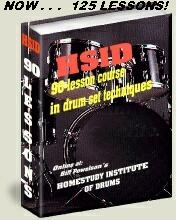ISSUE #24 \__\__\_______/__/__/ Dec. 5, 1998 _____________________________________________ TABLE OF CONTENTS: What is in this issue? Contents: 1. Feature Article: Playing Perfect Fills: ALL MYSTERIES SOLVED! 2. Humor: (Another sick Bass Player joke.) ______________________________________ |__________FEATURE ARTICLE___________| Playing Perfect Ad-lib Fills (rolls) in Mid-Song, EVERY TIME! Working drummers do essentially two things onstage, with the band. We play BEATS and ROLLS! Even our SOLOS' are made up of BEATS and ROLLS! The drummer who dies with the most BEATS and ROLLS . . . WINS! WHAT IS A FILL? A 'fill' is a very short ROLL the drummer may play on the snare drum, tom toms or other accessories, to 'FILL' the dead spots in a song. Usually, we may play a 'fill' when the vocalist or singer takes a breath between the verses of a song. Sometimes we play 'fills' to add dynamics as the band goes into the more exciting parts of a song, like the bridge, chorus or instrumental ride. Playing Perfect Fills: ALL MYSTERIES SOLVED! In this lesson, I want to help those of you who may be having trouble with fills and ROLLS. This is a very simple lesson, but it could save years of grief after you've learned to adapt it to the songs you'll be hearing every day. AD-LIB FILLS: Ad-lib fills, are fills we may create or invent on our own. We may do ANYTHING as a fill, if our TIMING doesn't get lost in the shuffle . . . . Our fill could be one note or 100 notes, provided we never lose track of the (bass drum) beat. THIS LESSON WILL TEACH YOU TO CONNECT WITH AD-LIB FILLS IN MID-SONG, EVERY TIME! NO MISTAKES! EVER! In a nutshell . . . IT IS ALL IN THE WAY WE USE THE BASS DRUM TO 'MARK-TIME' AS WE MOVE FROM A BEAT, TO A FILL, THEN BACK TO THE BEAT. Simply learn to maintain a steady bass drum to mark-time while playing every fill! Once this habit has been established, SOLID TIMING and thundering, explosive fills will be the end result. TO BE MORE SPECIFIC: As we play most beat patterns in 4/4, the bass is 'natural' when played as half-notes on the counts of 1 & 3. If we maintain the bass at a constant (half-note) tempo . . . and remember to return to the beat pattern on a bass note (any bass drum note) . . . it will always work out. IN A NUTSHELL . . . Play a Basic Rock beat with the bass on 1 & 3. That's the beat you learned in the 'Drummers Aptitude Test', (Lesson #1, on Lesson Menu #1.) Drop your fill. Play ANYTHING, on a tom or the snare, but keep your bass constant! Return to the beat on the next (or any) bass drum. The bass will always be at the same tempo. Each bass drum note represents the potential resumption of the beat you were playing before the fill. DO THIS RIGHT NOW! Play the 8TH 'ROCK' BEAT' we learned in the 'Aptitude' lesson! Just get it going and repeat it over and over . . . NOW, . . . STOP the hands completely, but keep the BASS DRUM going. That 'empty-time' between the bass drums . . . IS WHERE YOUR FILL WILL GO! go back to the beat ON ANY successive BASS DRUM! You just played a fill . . . but it was pretty lame! You didn't DO ANYTHING around the toms or other drums DURING THE EMPTY-TIME. NOW . . . DO THE SAME THING AGAIN . . . but DO SOMETHING during the dead-space, this time. * Play an IMPROVISED (ad-libbed) FILL . . . within the DEAD SPACE . . . then return to the beat. That's all there is to it! Practice many types of fill patterns using this same simple formula. Invent the fills up, as you go . . . or listen, then imitate the drummers you'll be hearing on your favorite recordings. Actually, ad-lib fills are mixed assortments of all the standard fills I'll be teaching you in my 100-lesson course. No matter what you decide to play as an ad-lib 'fill', it will end up being a mixed-bag of different note-value rolls and stroke-pattern arrangements . . . OR . . . THE VERY SAME rolls and fills I'll be showing you in the remainder of course. In other words, we can mix any roll-type with any other roll-type. We can do ANYTHING, and it will ALWAYS end up being SOMETHING, as long as we remain in-time with the music. AD-LIB 'FILL' SUGGESTIONS . . . Mix ANY note-value type (ie; 8thnotes, 16ths, whatever), with any other note- value type. (Mix fast notes with slower notes) . . . but keep one ear into the recorded music and return in-time with the recorded drummer, and the beat of the song. * Accent certain notes louder than others . . . * Rest or leave out notes randomly as you prefer . . . * Move to different parts of the kit, while doing all the above. IT'S A CORNUCOPIA OF IDEAS! The choices are endless and THERE ARE NO MISTAKES, if we maintain our timing, by . . . MARKING-TIME WITH THE BASS DRUM, and RETURN IN-TIME, WITH THE BEAT OF THE MUSIC. TO GET THE HANG OF THIS . . . You'll eventually want to LEARN ALL THE STANDARD, CLASSIC FILLS, in 'half-measure' segments, as they are taught later in my LARGE SERIES OF ONLINE LESSONS, entitled, 'Rudiments, Rolls and Fills'. In the structured lessons, you'll learn to play a bass drum note along with the first note of EACH HALF-MEASURE FILL SEGMENT, so that the BASS DRUM will ALWAYS BE CONSTANT, whether playing a BEAT OR A FILL. It becomes a HABIT after awhile. We'll learn ALL THE CLASSIC FILLS, this same way in the latter, more advanced lessons. All the lessons of the HOMESTUDY COURSE are set up with this (bass drum) trick in mind. As you learn to play the standard fills (ie; single strokes, double strokes, 8th triplets and paradiddles) the way they are shown in the lessons . . . your ability with ad-lib fills will quickly improve even more. It will become NATURAL HABIT, to mark-time with the bass drum, no matter what sort of improvised or ad-lib fill you may play. Also, later in the homestudy course, you will learn to extend all of the standard fills and a few others, to ANY LENGTH you choose. These standard fills may be varied around the kit, to any of the toms and stretched to any lengths, using this same 'half-measure' formula, marking-time with half notes on the bass drum. You'll easily and quickly discover that your fills may be ANY LENGTH, (ie; half-measure, whole-measure, one-and-one-half measures, two-measures or more.) It is the drummers choice and it is easy to accomplish, once we 'feel' the bass drum part and the half-measure segments of each fill, first. After that, it's a simple matter of doubling, tripling or quadrupling and mixing the half-measure patterns. ____________________________________ |_________THOUGHTS & GRINS__________| A drummer and a bass player were walking in the middle of a forest. Suddenly they saw a hungry tiger barely 10 feet away. The drummer calmly opened his knapsack and took out his jogging shoes. The bass player said " Hey you dummy . . . Do you think you can outrun a hungry tiger?" The drummer replied . . . " I only have to outrun you" END OF TEMPO DISPATCH #24 December 5, 1998
Finite To Infinity
3 very important questions
IS IT POSSIBLE THAT YOUR 'NATURAL GIFT' OF RHYTHM CAN BE DOUBLED WITH ONLY A LITTLE ADDITIONAL (PREVIOUSLY UNAVAILABLE), KNOWLEDGE?
IS THERE A 'KNOWLEDGE GAP' IN YOUR OWN UNDERSTANDING OF 'RHYTHM'?
IS IT POSSIBLE TO GAIN A COMPLETE AND THOROUGH UNDERSTANDING OF 'ALL RHYTHM', WITHIN ONLY A COUPLE HOURS OF EASY, AND FASCINATING, STUDY ?
Answers: YES! YES! YES!
Get All Products Here

GET ALL THE PRODUCTS AT ONE LOW PRICE.
SURPRISES ABOUND!!!! . . . For those with a bit of generosity in their soul.
CLICK HERE , to see what I mean.
Intermediate & Advanced Drummers
Your future is waiting.
- Drum Instructors Wanted
- Teach My Lessons and Methods
- Up to $60.00/hour
Pre-School Drummer?
YES!
Can we teach rhythm to pre-schoolers? YES!
This is a very short course, designed to help adults plant the seeds of rhythm into children of nearly any age. Click Here!!
Can we teach rhythm to pre-schoolers? YES!
This is a very short course, designed to help adults plant the seeds of rhythm into children of nearly any age. Click Here!!
Make CASH $$$ Now!!!

FREE ELECTRONIC BOOK BONUS (also included) BUSINESS OPPORTUNITY:
- * MAKE BIG MONEY SELLING USED DRUMSETS!
- * INSIDER HARDBALL-BUYING-TIPS AND SECRETS.
- * UNIQUE RECOVERING SECRETS
Support Us Today!!
Advertise Here!
Support this site and and gain an advetising bargain with the deal. Place a permanent ad here.
Support this site and and gain an advetising bargain with the deal. Place a permanent ad here.
